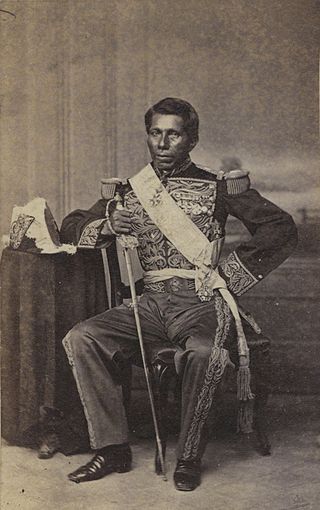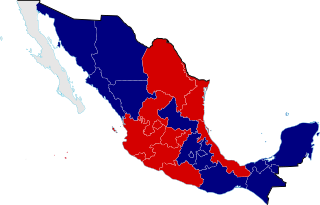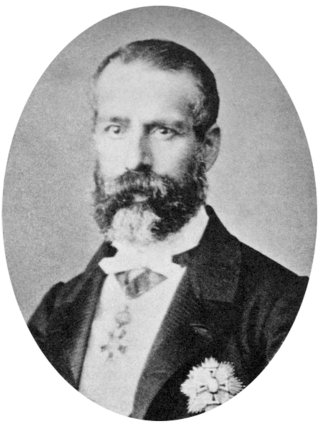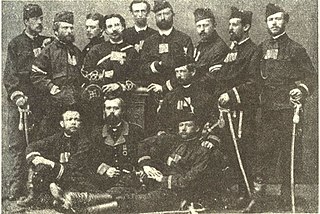Related Research Articles

Miguel Gregorio de la Luz Atenógenes Miramón y Tarelo, known as Miguel Miramón, was a Mexican conservative general who became president of Mexico at the age of twenty seven during the Reform War, serving between February 1859 and December 1860. He was the first Mexican president to be born after the Mexican War of Independence.

Nicolás Bravo Rueda was a Mexican soldier and politician who served as interim President of Mexico three times, in 1839, 1842, and 1846. Previously, he fought in the Mexican War of Independence, and served as Mexico's first Vice President under President Guadalupe Victoria from 1824 until 1827, when he attempted to overthrow Victoria. He was also the fourth vice president under President Mariano Paredes in 1846, and served in the Mexican–American War.

Félix María Zuloaga Trillo (1813–1898) was a Mexican conservative general and politician who played a key role in the outbreak of the Reform War in early 1860, a war which would see him elevated to the presidency of the nation. President Zuloaga was unrecognized by and fought against the liberals supporters of President Benito Juarez.

José Tomás de la Luz Mejía Camacho, better known as Tomás Mejía, was a Mexican soldier of Otomi background, who consistently sided with the Conservative Party throughout its nineteenth century conflicts with the Liberals.

The Reform War, or War of Reform, also known as the Three Years' War, and the Mexican Civil War, was a complex civil conflict in Mexico fought between Mexican liberals and conservatives with regional variations over the promulgation of Constitution of 1857. It has been called the "worst civil war to hit Mexico between the War of Independence of 1810-21 and the Revolution of 1910-20." Following the liberals' overthrow of the dictatorship of conservative Antonio López de Santa Anna, liberals passed a series of laws codifying their political program. These laws were incorporated into the new constitution. It aimed to limit the political power of the executive branch, as well as the political, economic, and cultural power of the Catholic Church. Specific measures were the expropriation of Church property; separation of church and state; reduction of the power of the Mexican Army by elimination of their special privileges; strengthening the secular state through public education; and measures to develop the nation economically.

Leonardo Márquez Araujo was a conservative Mexican general. He led forces in opposition to the Liberals led by Benito Juárez, but following defeat in the Reform War was forced to guerrilla warfare. Later, he helped the French in their intervention to help restore the conservative cause. However, their defeat forced him into exile for most of the rest of his life.
Tacubaya is a working-class area of west-central Mexico City, in the borough of Miguel Hidalgo, consisting of the colonia Tacubaya proper and adjacent areas in other colonias, with San Miguel Chapultepec sección II, Observatorio, Daniel Garza and Ampliación Daniel Garza being also considered part of Tacubaya.

The Battle of 2 de Abril was fought on April 2, 1867, in and around the city of Puebla, Puebla. It was one of the major military actions in the Franco-Mexican War between elements of the Mexican Army of the Republic commanded by General Porfirio Díaz and troops in the service of the Mexican Empire composed of Mexican imperialist soldiers.
The Liberal Party was a loosely organised political party in Mexico from 1822 to 1911. Strongly influenced by French Revolutionary thought, and the republican institutions of the United States, it championed the principles of 19th-century liberalism, and promoted republicanism, federalism, and anti-clericalism. They were opposed by, and fought several civil wars against, the Conservative Party.

The Battle of Barranca Seca was a battle of the Second French intervention in Mexico and took place right after the Battle of Puebla on 18 May 1862. Contrary to the latter it was won by the unified reactionist Mexican-French forces. The battle was preceded by a coup de chef of the reactionist forces, which was heated by the intrigue of the Spanish high command against Almonte and Márquez and French pressure towards the replacement of Zuloaga. After the battle Almonte remained the only contender for the Commander-in-Chief office within the reactionist party and Márquez as acting General; both of them serving French interests.

The siege of Mexico City was an 1867 military engagement in the Second French intervention in Mexico between Republican forces, aided by the United States, and Emperor Maximilian's troops, aided by the French Empire and Austria-Hungary, encompassing in the siege of the city. It was the last armed conflict of the Second Mexican Empire and the fall of the city resulted in the transition of the Empire into the Republic led by Benito Juárez.

The Plan of Tacubaya, sometimes called the Plan of Zuloaga, was issued by conservative Mexican General Félix Zuloaga on 17 December 1857 in Tacubaya against the liberal Constitution of 1857. The plan nullified the Constitution while it continued to recognize the election of moderate liberal Ignacio Comonfort as President. Conservatives had fiercely objected to the Constitution of 1857, which abolished special privileges of the Catholic Church and the Mexican Army. President Ignacio Comonfort had not been a strong supporter of the Constitution and joined with Zuloaga, commander of the garrison in Mexico City.

The Battle of Atlixco was fought on May 4, 1862 between the French invasion force and their Mexican imperial allies on one side and the Mexican republican forces on the other. The republicans were commanded by Tomas O'Horan, who later defected and was executed at the end of the war. The imperials were commanded by Leonardo Marquez, a veteran of the Mexican–American War and supporter of Miguel Miramón known as the "Tiger of Tacubaya". The two sides were evenly matched with 1,000 soldiers each. The republicans were victorious.

The siege of Querétaro was the culminating battle of the Second French intervention in Mexico and the Second Mexican Empire. It took place between Republican and Imperial armies from 6 March to 15 May 1867.

Juan Díaz Covarrubias was a Mexican writer and poet of liberal ideology. He was one of the Martyrs of Tacubaya who were executed during the War of the Reform in Mexico.
The Battle of Ahualulco took place on 29 September 1858 during the War of Reform, near the town of Ahualulco in the state of San Luis Potosí, Mexico, between elements of the liberal army, commanded by the Generals Santiago Vidaurri, Juan Zuazua and Francisco Naranjo and conservative army troops commanded by General Miguel Miramón and Leonardo Márquez. Vidaurri's army was defeated and the conservatives won the battle as the result. The liberals suffered 672 casualties and 91 prisoners. It is considered by some to be one of the most brilliant triumphs of Miramón.

The Battle of Calpulalpan took place on December 22, 1860 during the War of Reform in the vicinity of the community of San Miguel de la Victoria in the municipality of Jilotepec de Abasolo in the State of Mexico, Mexico. It would be the last battle of the War of Reform (1858-1860).
The Battle of Salamanca took place between 9 and 10 March 1858 in Salamanca, during Mexico's War of Reform (1858-1860). Elements of the liberal army, under General Anastasio Parrodi, governor of the Jalisco, fought with Generals Leandro Valle, Santos Degollado, and Mariano Moret, against conservatives, commanded by General Luis G. Osollo. Osollo's army had some 5,000 men, including Generals Miguel Miramón and Tomás Mejía, Francisco García Casanova. The conservatives won, handed the liberals a second liberal defeat, and forced them to retreat to Guadalajara from Guanajuato.
The Battle of Guadalajara (1858) took place on 14 December 1858 in the vicinity of La Hacienda de Atequiza, near the city of Guadalajara in the state of Jalisco, Mexico, during Reform War. Between elements of the liberal army, under General Santos Degollado, and elements of the conservative army commanded by Generals Miguel Miramón, Leonardo Márquez, Marcelino Cobos, the victory went to the conservative side. The conservatives attacked the ranch of San Miguel, near Poncitlán, Jalisco, where the battle took place. By the end of the battle, the conservatives had gained great quantities of weapons and other war materials. Afterwards, Miramón sent orders to shoot the captured liberal officers.

José Miguel Pascual Negrete Novoa, commonly known as Miguel Negrete was a 19th-century Mexican Major General. He participated in the many Mexican Civil Wars, as well as the Mexican–American War and the Second French intervention in Mexico. Negrete was also the Governor of Puebla from October 13, 1863, to November 4, 1863, and the Minister of War and Navy of Mexico from March 16, 1864 to August 23, 1865.